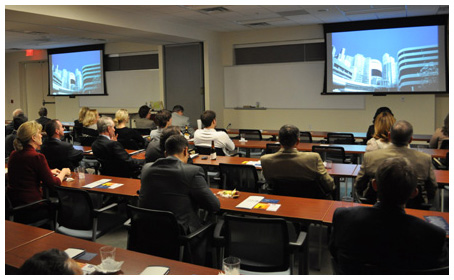 In Jim Kollaer’s blog Your Scenario or Mine?, he told you about a gathering hosted by Marek Brothers Houston on October 19 for a presentation and conversation about two alternative scenarios of what Houston may look like by the year 2040. The 2040 Scenarios are the result of research and analysis by the Center for Houston’s Future. The purpose of the evening was to use the possible scenarios to start a dialog about the future of a sustainable workforce, particularly for construction.
In Jim Kollaer’s blog Your Scenario or Mine?, he told you about a gathering hosted by Marek Brothers Houston on October 19 for a presentation and conversation about two alternative scenarios of what Houston may look like by the year 2040. The 2040 Scenarios are the result of research and analysis by the Center for Houston’s Future. The purpose of the evening was to use the possible scenarios to start a dialog about the future of a sustainable workforce, particularly for construction.
Following a light dinner and social hour, Stan Marek welcomed the attendees and introduced Catherine Mosbacher and 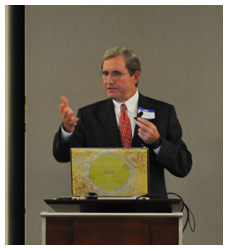 Donna Rybiski from the Center for Houston’s Future (“The Center”), who were there to present the videos for each of the two scenarios. Stan described the Center as “an inspired group of Houstonians, community leaders and great staff with a very diverse Board of Directors. He explained that the Scenario project was the inspiration of John Hofmeister of Shell Oil. Stan explained that Shell has used this “scenario planning” for years to look out to the future to see what their future business was going to look like. He stated that this evening would only be the second presentation of this program, and that as soon as he saw this the first time, he wanted others to see it.
Donna Rybiski from the Center for Houston’s Future (“The Center”), who were there to present the videos for each of the two scenarios. Stan described the Center as “an inspired group of Houstonians, community leaders and great staff with a very diverse Board of Directors. He explained that the Scenario project was the inspiration of John Hofmeister of Shell Oil. Stan explained that Shell has used this “scenario planning” for years to look out to the future to see what their future business was going to look like. He stated that this evening would only be the second presentation of this program, and that as soon as he saw this the first time, he wanted others to see it.
“This is all about construction, and it’s about our future. Most of you in this room are in our industry, and I knew the minute I saw this that we had to convene a group to talk about it. Our future starts tomorrow, so let’s talk about it.”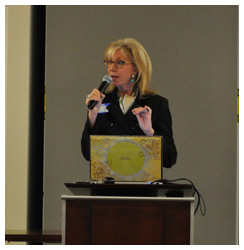 Next Catherine Mosbacher took the microphone to explain a little about the Center for Houston’s Future and to introduce the videos. She said that the Center has three main areas of focus: regional research, strategic planning, and business and civic leadership. She defined scenario as used in the project as a “plausible story about the future”. She explained that this differs from a vision and from a forecast. The scenarios are based in analysis and research, and logically plausible, but the Center is not predicting that either scenario will come to be. One scenario is not intended to be “good” and the other “bad”. They are meant to be thought provoking and to inspire dialog about what the future will be like. She asked the group to watch the video presentations and to “think about what makes you kind of uncomfortable, what is pleasing, and what it makes you feel like while you watch these videos.”
Next Catherine Mosbacher took the microphone to explain a little about the Center for Houston’s Future and to introduce the videos. She said that the Center has three main areas of focus: regional research, strategic planning, and business and civic leadership. She defined scenario as used in the project as a “plausible story about the future”. She explained that this differs from a vision and from a forecast. The scenarios are based in analysis and research, and logically plausible, but the Center is not predicting that either scenario will come to be. One scenario is not intended to be “good” and the other “bad”. They are meant to be thought provoking and to inspire dialog about what the future will be like. She asked the group to watch the video presentations and to “think about what makes you kind of uncomfortable, what is pleasing, and what it makes you feel like while you watch these videos.”
The two scenarios, Learning to Live and Playing to Win, were each presented with videos about 7 and a half 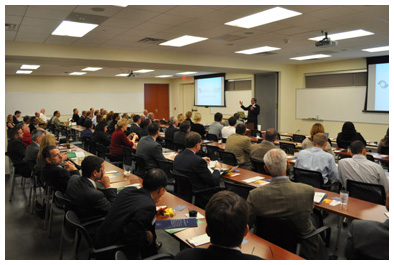 minutes long. In the first scenario, the region had evolved with a focus on environmental efforts, transportation efforts, improved access to quality education for everyone, and more compromise and collaboration to improve the quality of life for the entire community. Many of the improvements were made possible through higher taxes. In the second scenario, the region had grown through competition and global commerce, resulting in explosive economic growth and power and had attracted companies and talent from all over the world. However, the region had become a “tale of two cities”. While many citizens enjoyed living in a diverse multi-cultural and stimulating environment with access to talent, education and opportunity; there was also a class of “working poor” with little chance for any of those. This had created an environment of civil unrest and politics without common ground.
minutes long. In the first scenario, the region had evolved with a focus on environmental efforts, transportation efforts, improved access to quality education for everyone, and more compromise and collaboration to improve the quality of life for the entire community. Many of the improvements were made possible through higher taxes. In the second scenario, the region had grown through competition and global commerce, resulting in explosive economic growth and power and had attracted companies and talent from all over the world. However, the region had become a “tale of two cities”. While many citizens enjoyed living in a diverse multi-cultural and stimulating environment with access to talent, education and opportunity; there was also a class of “working poor” with little chance for any of those. This had created an environment of civil unrest and politics without common ground.
Stan Marek then offered a few remarks following the videos:
“Regardless of the scenario, in the next 30 years the built environment is going to duplicate itself. It’s going to be a lot of work, a lot of buildings, a lot of opportunity. What I kept hearing in [the videos] is education, skilled labor force – all the things we all talk about.”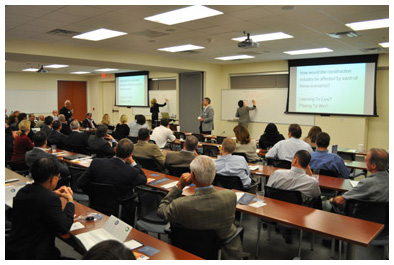 He then turned the microphone over to Mike Holland, Division President of Marek Brothers. Holland led a group discussion sparked with a few questions such as “How would the construction industry be affected by each of the scenarios?” and “Does anything about these scenarios seem to be a threat or an opportunity to the construction industry?” Catherine and Donna took notes from the group discussion on whiteboards at the front of the room.
He then turned the microphone over to Mike Holland, Division President of Marek Brothers. Holland led a group discussion sparked with a few questions such as “How would the construction industry be affected by each of the scenarios?” and “Does anything about these scenarios seem to be a threat or an opportunity to the construction industry?” Catherine and Donna took notes from the group discussion on whiteboards at the front of the room.
Mike then spoke to the group about our website, ConstructionCitizen.com, about the Houston Associated General Contractors’ initiative Construction Career Collaborative, and about what each person attending that evening could do to participate in the future of the industry.
Stan closed the evening with remarks about some of the issues the industry faces today: the image of the industry, the language barrier on many jobsites, lack of formal training for craftsmen, labor brokers and “independent 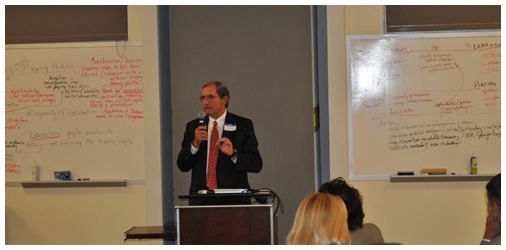 subcontractors”. These problems have led to a decline in the number of young people who consider construction careers. He stated:
subcontractors”. These problems have led to a decline in the number of young people who consider construction careers. He stated:
“We’ve lost 30 years of kids that should be in this industry. We’ve lost them and we will never get those back. We have to change the model. We’ve got to attract those kids into the industry. ... The built environment over the next 30 years is going to require skilled workers. ... Tonight we have taken the first step toward our future. Every one of you have seen the scenarios; I think you know what needs to happen. It’s our city, it’s our future, and only we can make it happen.”
In upcoming posts we will share reactions from some of the evening’s attendees.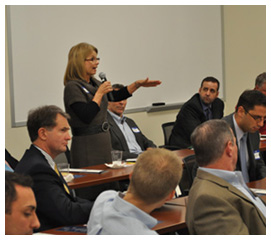
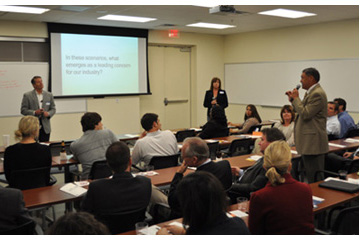
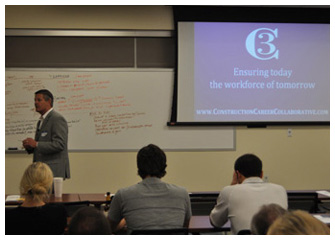
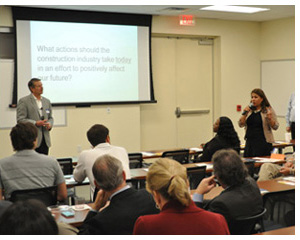
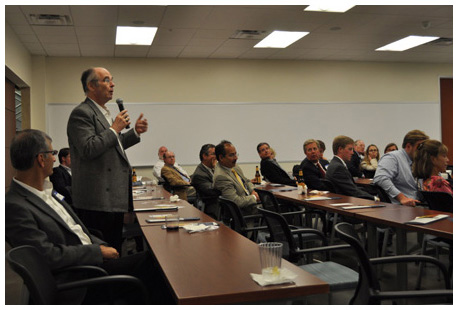
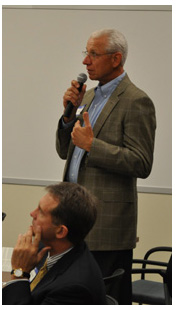
Community Professionals Presented with Scenarios for Houston’s Future
by Elizabeth McPherson | November 03, 2011



Add new comment